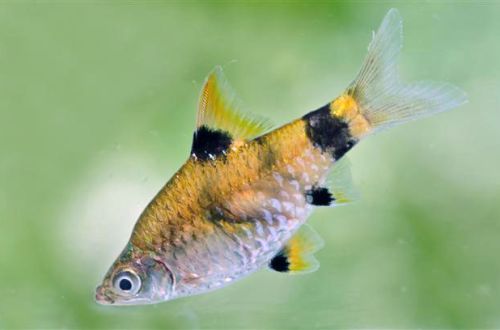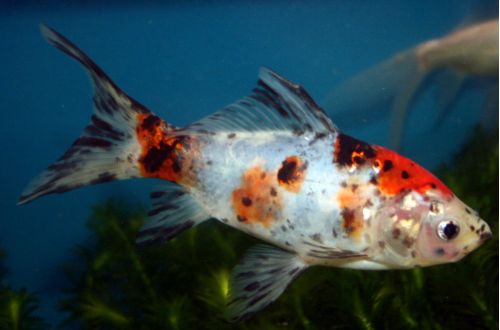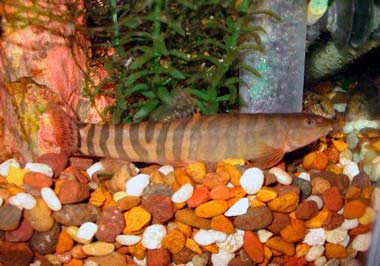
Sunny Barbus
The Sun Barb or Golden Dwarf Barb, scientific name Pethia gelius, belongs to the Cyprinidae family. A typical representative of cyprinids is unpretentious and easy to maintain, except for the need for protein food. It has a very peaceful, calm disposition, which is rare among barbs, although it would be strange to expect something else from such a miniature fish.

Contents
Habitat
It comes from the basin of the great river Ganges, is found on the territory of such modern states as India (north of the country), Nepal and Bangladesh. It lives in small rivers and channels with a slow current in muddy water and silty soil with dense coastal vegetation.
Brief information:
- The volume of the aquarium – from 60 liters.
- Temperature – 18-24°C
- Value pH — 6.0–7.0
- Water hardness – soft (1-10dGH)
- Substrate type – any silty
- Lighting – moderate / subdued
- Brackish water – no
- Water movement – minimum
- The size of the fish is about 4 cm.
- Meals – mostly meat
- Temperament – peaceful, timid
- Keeping in a flock of 8-10 individuals
Description
Adults rarely exceed 4 cm in length. Females are slightly larger than males, the latter look more elegant. The main color of the body has a yellow tint, there are several dark marks in the pattern, which are located on the dorsal and ventral fins, as well as at the base of the tail.
Food
Accepts all types of dry, frozen and live food. The optimal diet consists mainly of protein foods, while various flakes and granules should only be used as a supplement. Feed 2-3 times a day in the amount eaten in 5 minutes, all food residues are removed to avoid unnecessary contamination of the water.
Maintenance and care, arrangement of the aquarium
Recommended tank sizes for keeping one flock of fish start at 60 liters. The design uses a soft substrate, a certain amount of snags, branches or tree roots, rooted and floating plants. The latter, among other things, serve as a means of shading, scattering light.
In nature, the Sunny Barbus prefers regions with low current, and in the aquarium the main source of water movement is the filtration system, so when choosing a filter, be sure to consult with a specialist and choose the one that combines high performance, but at the same time creates an internal current. Other minimum required equipment consists of a heater, aerator and lighting system. Water conditions are characterized by slightly acidic pH values with low carbonate hardness. More about pH and dGH parameters in the section “Hydrochemical composition of water”.
Maintenance of the aquarium is reduced to the weekly replacement of part of the water (10-15% of the volume) with fresh, regular cleaning of the soil from glass waste from organic plaque.
Behavior and Compatibility
Peaceful timid fish, kept exclusively in a flock of at least 8-10 individuals. Being in a group Barbus feels safe, which contributes to the manifestation of his best color and natural behavior. Due to their modest size, the choice of neighbors is limited to fish of a similar size and temperament from among the characins and cyprinids. Can be kept with freshwater shrimp.
Breeding / breeding
Refers to spawning species, females attach eggs to the lower surface of the leaves of plants, and males at this moment fertilize it. Parental instincts are poorly developed, immediately after spawning, the fish can eat their own caviar and fry that have appeared. Able to breed throughout the year without much attention from the aquarist, however, due to the above reasons, the survival rate will be at a very low level.
In order to increase the chances and protect juveniles from adult fish, it is recommended to breed in a separate tank – a spawning aquarium. The design is the simplest, just a few plants are enough, for example creeping Ludwigia or Marsh Ludwigia, the leaves of which are considered an excellent basis for attaching eggs.
The size of the spawning aquarium for this species is usually about 20 liters, half filled. The equipment used is an aerator, a heater and a simple sponge airlift filter of low power to prevent accidental suction of eggs and fry. Spawning occurs in dim light, so at first there is no need for a light source.
The beginning of the mating season will be marked by the fact that the females become noticeably rounder, and the males will begin to actively show signs of attention to their chosen ones. At this point, you should prepare a separate tank and fill it with water from the general aquarium, then transplant several females and the most colorful males there. It remains to wait. The easiest way to determine the end of spawning is by females – they will become noticeably slimmer.
The fish are returned. The fry will appear in 24-36 hours, and after another 3-4 days they will begin to swim freely. Feed with specialized microscopic food for juvenile aquarium fish.
Fish diseases
A balanced diet and suitable living conditions are the best guarantee against the occurrence of diseases in freshwater fish, so if the first symptoms of an illness appear (discoloration, behavior), the first thing to do is check the condition and quality of the water, if necessary, return all values to normal, and only then do treatment. Read more about symptoms and treatments in the Aquarium Fish Diseases section.





